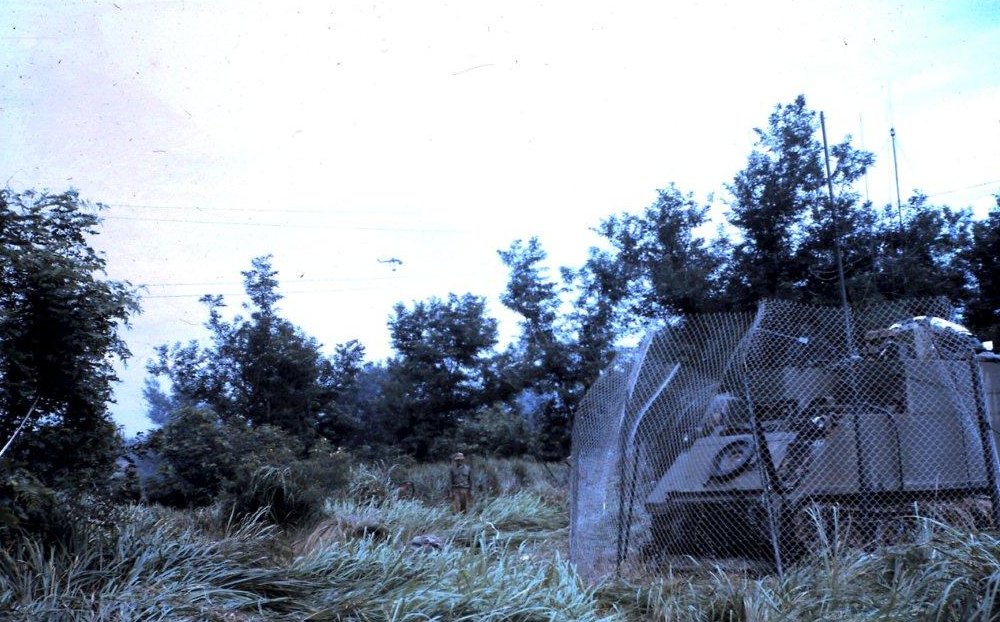Story 74
104 Sig Sqn Defence and Employment
By Denis Hare OAM BEM
"The area occupied
by the forward HQ complex is too large to be effectively protected
by
the Defence Platoon. Sigs must be made responsible for their
own security."(1)

Introduction
There were lots of valuable lessons for
Signals from the Battle of Coral Balmoral in May/June 1968.
One of the most important was the men became very fatigued working
long communication shifts after setting up the communication
equipment, plus the ongoing work to improve sector defences, gun pit
duties, clearing patrols, stand-to periods, etc. They also had
to keep digging their own pits ensuring overhead cover. Extra
manpower from the Squadron was flown in to assist and replace some
exhausted soldiers.
In the OC Communication Report
(2) post Operation Toan
Thang after the battle. The OC, 104 Sig Sqn Major Norm Munro proposed
the following
“Defence and Employment Section. On future
operations it is proposed to raise a D and E Section of one NCO and
ten to twelve men. The role of this section will be to provide
a force whose sole purpose is to construct defences and man the
perimeter pits. This section will ease the pressure on the
remaining personnel of the Fwd Op Sigs Gp in the first few days of
deployment. Once satisfactory defences are completed the
section would return to NUI DAT. If sufficient notice of
deployment is given it is proposed that the D&E Section would
undergo concentrated weapon handling and practice firing course.”
First Deployment
Defence and Employment Section

Denis Hare at FSPB Lion
 104
Sig Sqn ACV (Callsign 85C) SIGCEN at FSPB Lion
104
Sig Sqn ACV (Callsign 85C) SIGCEN at FSPB Lion
Note the wire to help protect against incoming rockets
Outside the Wire
I got the opportunity while at the FSPB to do a
day infantry platoon patrol east of road 328. During this
patrol we located a number of bunker systems. The
bunkers were very well built from bush material (tree trunks, etc)
with lots of overhead cover. Dirt from the bunkers, not used
in construction, was carried and deposited around tree bases to aid
concealment from the air. We put up balloons so the bunkers
could be relocated and destroyed later.

Conclusion
Additional signals
personnel for our sector setup and defence became a
Standard Operating Procedure (SOP) for 104 Sig Sqn deployments with
HQ 1ATF (Forward)
in South Vietnam post the Battle of Coral Balmoral
104 Sig Sqn in support of HQ 1ATF
(Forward) deployed a D&E section in South Vietnam for the last time
on Operation Overlord, June 1971 to Courtenay Hill
(4). The group
deployed for the first three days under the direction of the SSM and
include ten signalmen before returning to Nui Dat.
 Comment: The Task Force Signal Squadrons of the
Vietnam War were not only communicators but combat troops as per the
RASigs role. However they were the only Arms Corps soldiers as
part of the 1ATF Order of Battle (ORBAT) who weren’t
granted retrospective approval for the Army Combat Badge (ACB)
after 90 days service when it was introduced in 2005.
Comment: The Task Force Signal Squadrons of the
Vietnam War were not only communicators but combat troops as per the
RASigs role. However they were the only Arms Corps soldiers as
part of the 1ATF Order of Battle (ORBAT) who weren’t
granted retrospective approval for the Army Combat Badge (ACB)
after 90 days service when it was introduced in 2005.
1. Commander's Analysis from Op
Hayman (First HQ 1ATF/103 Sig Sqn deployment forward from Nui Dat in
1966).
Commanding Officer After Action Report,
Operation Hayman AWM95-1-4-27, Page 17.
2. OC Communications
Report – See
http://www.au104.org/Memorabilia/Mem-8.htm
Para 24d.
3. Training Report – 104 Sig Sqn – See
http://www.au104.org/Memorabilia/Mem-18.htm
Part 5 - Defence
4. Report on Operation Overload, Annex A to 104
Sig Sqn Monthly Report – Jul 71. See Para 16d.
The report is part of 104 Sig Sqn War Diary
AWM95-6-2-52.
